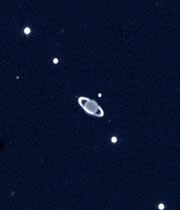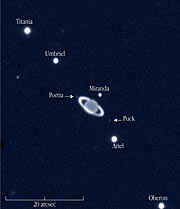Communiqué de presse
Which Ringed Planet...!?
VLT Obtains Unusual View of Well-Known Solar System Object
20 décembre 2002
Don't worry - you are not the only one who thought this was a nice amateur photo of planet Saturn, Lord of the Rings in our Solar System! But then the relative brightness and positions of the moons may appear somewhat unfamiliar... and the ring system does look unusually bright when compared to the planetary disk...?? Well, it is not Saturn, but Uranus , the next giant planet further out, located at a distance of about 3,000 million km, or 20 times the distance between the Sun and the Earth.
The photo shows Uranus surrounded by its rings and some of the moons, as they appear on a near-infrared image that was obtained in the K s -band (at wavelength 2.2 µm) with the ISAAC multi-mode instrument on the 8.2-m VLT ANTU telescope at the ESO Paranal Observatory (Chile). The exposure was made on November 19, 2002 (03:00 hrs UT) during a planetary research programme. The observing conditions were excellent (seeing 0.5 arcsec) and the exposure lasted 5 min. The angular diameter of Uranus is about 3.5 arcsec.
The observers at ISAAC were Emmanuel Lellouch and Thérése Encrenaz of the Observatoire de Paris (France) and Jean-Gabriel Cuby and Andreas Jaunsen (both ESO-Chile).
The rings
The rings of Uranus were discovered in 1977, from observations during a stellar occultation event by astronomer teams at the Kuiper Airborne Observatory (KAO) and the Perth Observatory (Australia). Just before and after the planet moved in front of the (occulted) star, the surrounding rings caused the starlight to dim for short intervals of time. Photos obtained from the Voyager-2 spacecraft in 1986 showed a multitude of very tenuous rings. These rings are almost undetectable from the Earth in visible light.
However, on the present VLT near-infrared picture, the contrast between the rings and the planet is strongly enhanced. At the particular wavelength at which this observation was made, the infalling sunlight is almost completely absorbed by gaseous methane present in the planetary atmosphere and the disk of Uranus therefore appears unsually dark. At the same time, the icy material in the rings reflects the sunlight and appears comparatively bright.
Uranus is unique among the planets of the solar system in having a tilted rotation axis that is close to the main solar system plane in which most planets move (the "Ecliptic"). At the time of the Voyager-2 encounter (1986), the southern pole was oriented toward the Earth. Now, sixteen years later (corresponding to about one-fifth of Uranus' 84-year period of revolution), we observe the Uranian ring system at an angle that is comparable to the one under which we see Saturn when its ring system is most "open".
The moons
Seven of the moons of Uranus have been identified in ESO Press Photo eso0237b [1]. Of these, Titania and Oberon are the brightest (visual magnitude about 14). They were first seen in 1787 by the discoverer of Uranus, William Herschel (1738-1822), working at Bath in England. Ariel and Umbriel were found in 1851 by William Lassell (1799-1880) at Liverpool in the same country. Miranda was discovered in 1948 by Gerard Kuiper (1905-1973) at the 5-m Palomar telescope in California (USA).
The much smaller and fainter Puck and Portia (visual magnitude about 21 and barely visible in the photo) were first found in 1985-86 by Stephen P. Synnott of the Jet Propulsion Laboratory (USA), during a study of Voyager-2 photos obtained soon before this NASA spacecraft flew by Uranus in January 1986.
Other VLT images
If you now want to see a fine VLT photo of Saturn, please look at ESO Press Photo eso0204a, obtained in late 2001. It was made with the NAOS-CONICA (NACO) Adaptive Optics facility and is therefore much less influenced by atmospheric turbulence and hence correspondingly sharper than the present ISAAC image of Uranus.
Notes
[1] Historic information about the discovery of Uranus' moons is available at the History of Astronomy website. There is also a very useful list of planet and satellite names and discoverers at the IAU Gazetteer of Planetary Nomenclature website.
Liens
Historic information about the discovery of Uranus' moons is available at the History of Astronomy website: http://www.astro.uni-bonn.de/~pbrosche/astoria.html
A propos du communiqué de presse
| Communiqué de presse N°: | eso0237 |
| Legacy ID: | Photo 31a-b/02 |
| Nom: | Uranus |
| Type: | Solar System : Planet Solar System : Planet : Satellite |
| Facility: | Very Large Telescope |
| Instruments: | ISAAC |
Our use of Cookies
We use cookies that are essential for accessing our websites and using our services. We also use cookies to analyse, measure and improve our websites’ performance, to enable content sharing via social media and to display media content hosted on third-party platforms.
ESO Cookies Policy
The European Organisation for Astronomical Research in the Southern Hemisphere (ESO) is the pre-eminent intergovernmental science and technology organisation in astronomy. It carries out an ambitious programme focused on the design, construction and operation of powerful ground-based observing facilities for astronomy.
This Cookies Policy is intended to provide clarity by outlining the cookies used on the ESO public websites, their functions, the options you have for controlling them, and the ways you can contact us for additional details.
What are cookies?
Cookies are small pieces of data stored on your device by websites you visit. They serve various purposes, such as remembering login credentials and preferences and enhance your browsing experience.
Categories of cookies we use
Essential cookies (always active): These cookies are strictly necessary for the proper functioning of our website. Without these cookies, the website cannot operate correctly, and certain services, such as logging in or accessing secure areas, may not be available; because they are essential for the website’s operation, they cannot be disabled.
Functional Cookies: These cookies enhance your browsing experience by enabling additional features and personalization, such as remembering your preferences and settings. While not strictly necessary for the website to function, they improve usability and convenience; these cookies are only placed if you provide your consent.
Analytics cookies: These cookies collect information about how visitors interact with our website, such as which pages are visited most often and how users navigate the site. This data helps us improve website performance, optimize content, and enhance the user experience; these cookies are only placed if you provide your consent. We use the following analytics cookies.
Matomo Cookies:
This website uses Matomo (formerly Piwik), an open source software which enables the statistical analysis of website visits. Matomo uses cookies (text files) which are saved on your computer and which allow us to analyze how you use our website. The website user information generated by the cookies will only be saved on the servers of our IT Department. We use this information to analyze www.eso.org visits and to prepare reports on website activities. These data will not be disclosed to third parties.
On behalf of ESO, Matomo will use this information for the purpose of evaluating your use of the website, compiling reports on website activity and providing other services relating to website activity and internet usage.
Matomo cookies settings:
Additional Third-party cookies on ESO websites: some of our pages display content from external providers, e.g. YouTube.
Such third-party services are outside of ESO control and may, at any time, change their terms of service, use of cookies, etc.
YouTube: Some videos on the ESO website are embedded from ESO’s official YouTube channel. We have enabled YouTube’s privacy-enhanced mode, meaning that no cookies are set unless the user actively clicks on the video to play it. Additionally, in this mode, YouTube does not store any personally identifiable cookie data for embedded video playbacks. For more details, please refer to YouTube’s embedding videos information page.
Cookies can also be classified based on the following elements.
Regarding the domain, there are:
- First-party cookies, set by the website you are currently visiting. They are stored by the same domain that you are browsing and are used to enhance your experience on that site;
- Third-party cookies, set by a domain other than the one you are currently visiting.
As for their duration, cookies can be:
- Browser-session cookies, which are deleted when the user closes the browser;
- Stored cookies, which stay on the user's device for a predetermined period of time.
How to manage cookies
Cookie settings: You can modify your cookie choices for the ESO webpages at any time by clicking on the link Cookie settings at the bottom of any page.
In your browser: If you wish to delete cookies or instruct your browser to delete or block cookies by default, please visit the help pages of your browser:
Please be aware that if you delete or decline cookies, certain functionalities of our website may be not be available and your browsing experience may be affected.
You can set most browsers to prevent any cookies being placed on your device, but you may then have to manually adjust some preferences every time you visit a site/page. And some services and functionalities may not work properly at all (e.g. profile logging-in, shop check out).
Updates to the ESO Cookies Policy
The ESO Cookies Policy may be subject to future updates, which will be made available on this page.
Additional information
For any queries related to cookies, please contact: pdprATesoDOTorg.
As ESO public webpages are managed by our Department of Communication, your questions will be dealt with the support of the said Department.


